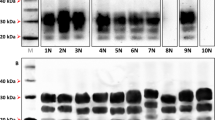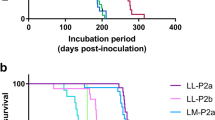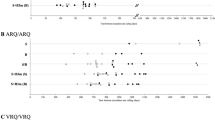Abstract
SCRAPIE and related animal and human disorders are neurodegenerative diseases1 characterized by the formation of a modified, partly proteinase-resistant protein (PrP) of the host2,3,which tends to aggregate as amyloid fibrils4 and accumulate in the brain of infected individuals5. There is a general consensus that the pathological form of PrP (PrPSc) is essential for the clinical appearance of the disease6, but whether it is part of the scrapie agent7 or a by-product of viral infection8,9is still controversial. Here we report that treatment of scrapie-infected hamsters with amphotericin B delays the accumulation in the brain of the proteinase-resistant portion of PrPSc by about 30 days without affecting scrapie replication. The consequence is that hamsters treated with amphotericin B developed clinical signs of disease later than infected controls. We argue that the proteinase-resistant portion of PrPSc is necessary for the development of the disease but that it is unlikely to be essential for scrapie replication.
This is a preview of subscription content, access via your institution
Access options
Subscribe to this journal
Receive 51 print issues and online access
$199.00 per year
only $3.90 per issue
Buy this article
- Purchase on Springer Link
- Instant access to full article PDF
Prices may be subject to local taxes which are calculated during checkout
Similar content being viewed by others
References
Gajdusek, D. C. in Virology (eds Fields, B. N. & Knipe, D. M.) 2289–2324 (Raven, New York, 1990).
Oesch, B. et al. Cell 40, 735–746 (1985).
Chesebro, B. et al. Nature 315, 331–333 (1985).
Prusiner, S. B. et al. Cell 35, 349–358 (1983).
McKinley, M. P., Bolton, D. C. & Prusiner, S. B. Cell 35, 57–62 (1983).
Brunori, M., Silvestrini, M. C. & Pocchiari, M. Trends biochem. Sci. 13, 309–313 (1988).
Prusiner, S. B. Science 252, 1515–1522 (1991).
Braig, H. R. & Diringer, H. EMBO J. 4, 2300–2309 (1985).
Manuelidis, L., Sklaviadis, T. & Manuelidis, E. E. EMBO J. 6, 341–347 (1987).
Pocchiari, M., Schmittinger, S. & Masullo, C. J. gen. Virol. 68, 219–223 (1987).
Casaccia, P. et al. Antimicrob. Agents Chemother. 35, 1486–1488 (1991).
Pocchiari, M., Casaccia, P. & Ladogana, A. J. infect. Dis. 160, 795–802 (1989).
Kimberlin, R. H., Walke, C. A. & Fraser, H. J. gen. Virol. 70, 2017–2025 (1989).
Diringer, H. et al. Nature 306, 476–478 (1983).
Motulsky, H. J. & Ransnas, L. A. FASEB J. 1, 365–374 (1987).
Reed, J. & Muench, H. Am. J. Hyg. 27, 493–497 (1938).
Prusiner, S. B. et al. Biochemistry 19, 4883–4891 (1980).
Hope, J., Multhaup, G., Reekie, L. J. D., Kimberlin, R. H. & Beyreuther, K. Eur. J. Biochem. 172, 271–277 (1988).
Medoff, G., Brajtburg, J., Kobayashi, G. S. & Bolard, J. A. Rev. Pharmac. Toxicol. 23, 303–330 (1983).
Dickinson, A. G. & Outram, G. W. Ciba Fdn Symp. 135, 209–223 (1988).
Weissmann, C. Nature 352, 679–683 (1991).
Kimberlin, R. H. & Walker, C. A. J. gen. Virol. 34, 295–304 (1977).
Kimberlin, R. H., Cole, S. & Walker, C. A. J. gen. Virol. 68, 1875–1881 (1987).
Dickinson, A. G. in Slow Virus Diseases of Animals and Man (ed. Kimberlin, R. H.) 209–241 (North Holland, Amsterdam, 1976).
Pocchiari, M. & Masullo, C. in Neurologia e Scienze di Base (eds Gainotti, G., Bentivoglio, M., Bergonzi, P. & Ferro, F. M.) 571–582 (Vita e Pensiero, Milano, 1989).
De Lean, A., Munson, P. J. & Rodbard, D. Am. J. Physiol. 235, E97–E102 (1978).
Hilmert, H. & Diringer, H. Biosci. Rep. 4, 165–170 (1984).
Kascsak, R. J. et al. J. Virol. 59, 676–683 (1986).
Laemmli, U. K. Nature 227, 680–685 (1970).
Towbin, H., Staehelin, T. & Gorden, J. Proc. natn. Acad. Sci. U.S.A. 76, 4350–4354 (1979).
Casaccia, P., Ladogana, A., Masullo, C., Macchi, G. & Pocchiari, M. in Trends Neuroimmun. (eds Marrosu, M. G., Cianchetti, C. & Tavolato, B.) 135–149 (Plenum, New York, 1990).
Author information
Authors and Affiliations
Rights and permissions
About this article
Cite this article
Xi, Y., Ingrosso, L., Ladogana, A. et al. Amphotericin B treatment dissociates in vivo replication of the scrapie agent from PrP accumulation. Nature 356, 598–601 (1992). https://doi.org/10.1038/356598a0
Received:
Accepted:
Issue Date:
DOI: https://doi.org/10.1038/356598a0
This article is cited by
-
Agent-specific Shadoo Responses in Transmissible Encephalopathies
Journal of Neuroimmune Pharmacology (2010)
-
Identification of the prion protein allotypes which accumulate in the brain of sporadic and familial Creutzfeldt-Jakob disease patients
Nature Medicine (1997)
Comments
By submitting a comment you agree to abide by our Terms and Community Guidelines. If you find something abusive or that does not comply with our terms or guidelines please flag it as inappropriate.



